| Pages:
1
2 |
Weeblordd
Harmless

Posts: 20
Registered: 6-8-2018
Member Is Offline
Mood: high power <3
|
|
How to plasticize ETN with SBR (styrene-butadiene rubber)?
I've read in various threads that ETN can be plasticized with styrene-butadiene rubber, apparently 9/1 ETN/SBR respectively makes a professional grade
plastic explosive and I find that SBR rubber is OTC here easy to buy for cheap in large amounts. Can someone explain how to plasticize ETN or any high
explosive with SBR rubber? or do you soften the SBR with toluene and add ETN to it, mold it up like playdough and you're good to go? This info is hard
to find, give me some pointers please
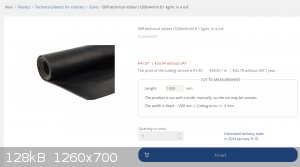
|
|
|
DennyDevHE77
Hazard to Others
  
Posts: 148
Registered: 15-9-2014
Member Is Offline
Mood: No Mood
|
|
That's usually how it's done. The polymer dissolves in the right solvent (toluene \ gasoline \ and others) after which, right along with the solvent,
it gets mixed (in a container so as not to spread) and as a result, a plastic explosive is obtained. I was also advised to grind everything in a
mortar during mixing, this is good advice, but the mortar will get dirty all over.
Personally, I really prefer to use mouse adhesives, usually it is already an oil-diluted polymer, the main thing is to find the right one, not too
diluted. And there you can mix it purely mechanically.
By the way, someone here made a good video about the extraction of polymer from tapes, but I don't remember who
I would also like to add that for a high-quality plastic substance, you need bimodal explosives. That is, two factions, large and small. This is
important to achieve high density along with high ductility. I have already thrown earlier (although RDX with fluoro-organic), but I will reset it
again.
"For a blend of 90-90.5% RDX, 3.5-4% fluoroorganics, and the rest is dibutyl phthalate:
1) RDX fraction <50µm 90% density = 1.38 g/ml [VoD 7220 m/s]
2) RDX fraction <50µm 45%, 200-250µm 45% density = 1.54 g/ml [VoD 7690 m/s]
3) RDX fraction <50µm 26.82%, 200-250µm 63.64% density = 1.58 g/ml [VoD 7920 m/s]
4) RDX fraction <50µm 26.82%, 120-200µm 63.64% density = 1.55 g/ml [VoD 7710 m/s]
5) RDX fraction <50µm 26.82%, 80-120µm 63.64% density = 1.51 g/ml [VoD 7640 m/s]
6) RDX fraction <50µm 38.5%, 100-300µm 51.95% density = 1.67 g/ml [VoD 8130 m/s]
Although this is of course fluoroorganics, and exotic for the home chemist, I think with hydrocarbon/fatty acid salt mixtures, or PiB, the difference
would not be particularly large"
I have decided right now to convert the remains of petn (after the New Year celebration) into plastic, maybe I will show you some steps below
[Edited on 5-1-2024 by DennyDevHE77]
|
|
|
Sir_Gawain
Hazard to Others
  
Posts: 272
Registered: 12-10-2022
Location: Due South of Due West
Member Is Offline
Mood: Yes.
|
|
It’s Laboratory of Liptakov. The type of tape that he uses can be hard to find, however.
“Alchemy is trying to turn things yellow; chemistry is trying to avoid things turning yellow.” -Tom deP.
|
|
|
fx-991ex
Hazard to Self
 
Posts: 67
Registered: 20-5-2023
Member Is Offline
|
|
Scapa 2501, cant find it in canada, mostly from uk.
|
|
|
dettoo456
Hazard to Others
  
Posts: 178
Registered: 12-9-2021
Member Is Offline
|
|
Shoe GOO (sold in the US commonly) contains styrene-butadiene with Toluene and naphtha. You can try to experiment with that and some powdered sugar
and solvent of choice. If you haven’t plasticized an EM before in a proven method before though, start with inert materials first.
|
|
|
DennyDevHE77
Hazard to Others
  
Posts: 148
Registered: 15-9-2014
Member Is Offline
Mood: No Mood
|
|
Quote: Originally posted by DennyDevHE77  | | I have decided right now to convert the remains of petn (after the New Year celebration) into plastic, maybe I will show you some steps below
|
Since I said it yesterday, here's how I make plastic.
First you have to find a surface, ideally a window sill, but in my case it's a sheet of foil on my desk, the kneading process is long and I'm watching
anime. Do not forget to bend the sheet of foil, so that the explosives do not fall out (in my case PETN), as well as of course you need to measure the
mass of your explosives.
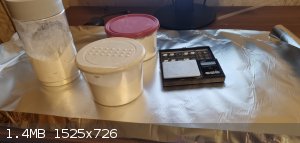
After that, pour out the PETN in a mound, and make a depression in the middle.
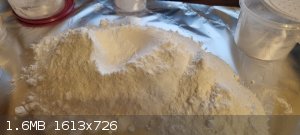
Now you need to measure out the right amount of binder, in my case it's mouse glue. I have a total of 946 g of PETN, so I need 105 g of binder, for a
90/10 composition. With a glue density of 0.9, this is 116 ml. You can measure it with a syringe, for small amounts (but don't use a syringe for 20 ml
or more, it's very heavy), or you can just pour it into a beaker.
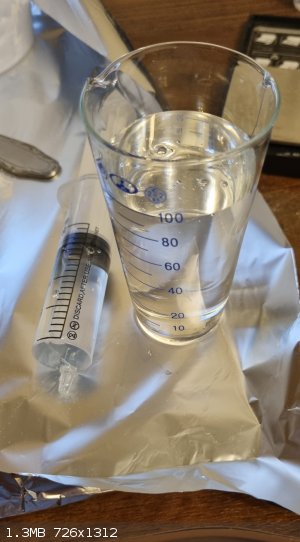
Then pour the glue into the depression in the mountain, and start kneading, it took me 5 series of 22 minutes to more or less mix everything.
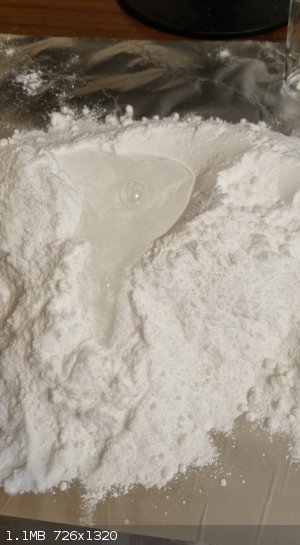
At some point you will get weird kinetic sand, but don't despair, just keep mixing, sooner or later you will be able to "glue" a significant amount
of explosives into clumps.
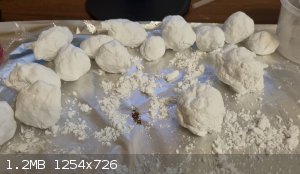
Then simple hand kneading becomes almost ineffective in such quantities, in my case I transferred all the PETN to the window sill, and began to roll
with a rolling pin, this is also not fast. Here came out such pancakes. It is worth to roll them out. But first of all, I often use plastic explosive
as a pressed composition. In the second part of the glue was left in the beaker and on the foil, so I guess I got the composition not 90 by 10, but 91
by 9, or even lower. Not good for plasticity, but it should be very good for pressing.
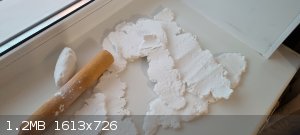
I want to say right away that I do not advise you to make plastic in kilograms. It is better to do it a few times 100-200 grams at a time. It will be
faster and of higher quality than a lot at once. And if you take 20-30 grams at a time, you can do without a rolling pin. Don't forget to wash it with
gasoline afterwards, by the way.
[Edited on 6-1-2024 by DennyDevHE77]
|
|
|
dettoo456
Hazard to Others
  
Posts: 178
Registered: 12-9-2021
Member Is Offline
|
|
It looks like you have too much oil in your PBX, but it’d probably be fine for charges that won’t be malleable. The mouse glue isn’t high enough
MW, usually a high MW polymer in conjunction with a small amount of oil and a plasticizer like DOP or DOS is used instead of a single, mid-range MW
polymer.
The tear test is a good measure of plasticity; just pick up a clump of the plastic and try to tear it between both hands. It shouldn’t be too
stringy or too loose and should tear cleanly after moderate force is applied. Modeling clay is a good target to match a PBX to.
|
|
|
Laboratory of Liptakov
International Hazard
    
Posts: 1339
Registered: 2-9-2014
Location: Technion Haifa
Member Is Offline
Mood: cool.gif
|
|
SCAPA 2501 has 2 advantages. 1 - Contains PIB with ideal molecular weight. 2 - the black carrier does not dissolve in gasoline together with PIB. So
the resulting PIB dissolved in gasoline is clear. With other self-vulcanizing tapes, the black carrier is also dissolved in gasoline. Which
invalidates the result. For easy counting, it is advisable to adjust the concentration on 10% PIB in gasoline. The basic proportions are: 90g of
powder (XY) + 50g of PIB in gasoline + 5g of 5W40 oil. After the gasoline evaporates during kneading, a composition of 90g xy + 10g binder is created.
For high plastic properties is ratio: 88g xy + 50g (PIB in gasoline 10%) + 7 g 5W40. For shaped charge (press tools) is enough only 4% of basic
binder. After pressing is material a like stone. Despite only 4% of binder.
https://www.youtube.com/watch?v=hB8mdSSKPoE
Development of primarily - secondary substances CHP (2015) Lithex (2022) Brightelite (2023) Nitrocelite (2024)
|
|
|
ManyInterests
National Hazard
   
Posts: 843
Registered: 19-5-2019
Member Is Offline
|
|
Quote: Originally posted by DennyDevHE77  | That's usually how it's done. The polymer dissolves in the right solvent (toluene \ gasoline \ and others) after which, right along with the solvent,
it gets mixed (in a container so as not to spread) and as a result, a plastic explosive is obtained. I was also advised to grind everything in a
mortar during mixing, this is good advice, but the mortar will get dirty all over.
Personally, I really prefer to use mouse adhesives, usually it is already an oil-diluted polymer, the main thing is to find the right one, not too
diluted. And there you can mix it purely mechanically.
By the way, someone here made a good video about the extraction of polymer from tapes, but I don't remember who
I would also like to add that for a high-quality plastic substance, you need bimodal explosives. That is, two factions, large and small. This is
important to achieve high density along with high ductility. I have already thrown earlier (although RDX with fluoro-organic), but I will reset it
again.
"For a blend of 90-90.5% RDX, 3.5-4% fluoroorganics, and the rest is dibutyl phthalate:
1) RDX fraction <50µm 90% density = 1.38 g/ml [VoD 7220 m/s]
2) RDX fraction <50µm 45%, 200-250µm 45% density = 1.54 g/ml [VoD 7690 m/s]
3) RDX fraction <50µm 26.82%, 200-250µm 63.64% density = 1.58 g/ml [VoD 7920 m/s]
4) RDX fraction <50µm 26.82%, 120-200µm 63.64% density = 1.55 g/ml [VoD 7710 m/s]
5) RDX fraction <50µm 26.82%, 80-120µm 63.64% density = 1.51 g/ml [VoD 7640 m/s]
6) RDX fraction <50µm 38.5%, 100-300µm 51.95% density = 1.67 g/ml [VoD 8130 m/s]
Although this is of course fluoroorganics, and exotic for the home chemist, I think with hydrocarbon/fatty acid salt mixtures, or PiB, the difference
would not be particularly large"
I have decided right now to convert the remains of petn (after the New Year celebration) into plastic, maybe I will show you some steps below
[Edited on 5-1-2024 by DennyDevHE77] |
Your description on using mouse glue is the most detailed I have ever seen. Mouse glue traps are everywhere where I live (Canada) but I once tried to
use charcoal lighter fluid (a petroleum distillate) to dissolve it, but it failed. How do you get the mouse glue dissolved from the pads? I have
toluene but I would rather use something else. Does the gasoline have to be gasoline from a gas station or is the petroleum distillate from charcoal
lighter fluid/zippo lighter fluid sufficient and I just did something wrong?
I did have success with the victor rubber cement + bar & chain oil (all seasons), and while I think that all rubber cement nowadays is acid-free,
I still would rather try something else.
|
|
|
fx-991ex
Hazard to Self
 
Posts: 67
Registered: 20-5-2023
Member Is Offline
|
|
Quote: Originally posted by ManyInterests  | Quote: Originally posted by DennyDevHE77  | That's usually how it's done. The polymer dissolves in the right solvent (toluene \ gasoline \ and others) after which, right along with the solvent,
it gets mixed (in a container so as not to spread) and as a result, a plastic explosive is obtained. I was also advised to grind everything in a
mortar during mixing, this is good advice, but the mortar will get dirty all over.
Personally, I really prefer to use mouse adhesives, usually it is already an oil-diluted polymer, the main thing is to find the right one, not too
diluted. And there you can mix it purely mechanically.
By the way, someone here made a good video about the extraction of polymer from tapes, but I don't remember who
I would also like to add that for a high-quality plastic substance, you need bimodal explosives. That is, two factions, large and small. This is
important to achieve high density along with high ductility. I have already thrown earlier (although RDX with fluoro-organic), but I will reset it
again.
"For a blend of 90-90.5% RDX, 3.5-4% fluoroorganics, and the rest is dibutyl phthalate:
1) RDX fraction <50µm 90% density = 1.38 g/ml [VoD 7220 m/s]
2) RDX fraction <50µm 45%, 200-250µm 45% density = 1.54 g/ml [VoD 7690 m/s]
3) RDX fraction <50µm 26.82%, 200-250µm 63.64% density = 1.58 g/ml [VoD 7920 m/s]
4) RDX fraction <50µm 26.82%, 120-200µm 63.64% density = 1.55 g/ml [VoD 7710 m/s]
5) RDX fraction <50µm 26.82%, 80-120µm 63.64% density = 1.51 g/ml [VoD 7640 m/s]
6) RDX fraction <50µm 38.5%, 100-300µm 51.95% density = 1.67 g/ml [VoD 8130 m/s]
Although this is of course fluoroorganics, and exotic for the home chemist, I think with hydrocarbon/fatty acid salt mixtures, or PiB, the difference
would not be particularly large"
I have decided right now to convert the remains of petn (after the New Year celebration) into plastic, maybe I will show you some steps below
[Edited on 5-1-2024 by DennyDevHE77] |
Your description on using mouse glue is the most detailed I have ever seen. Mouse glue traps are everywhere where I live (Canada) but I once tried to
use charcoal lighter fluid (a petroleum distillate) to dissolve it, but it failed. How do you get the mouse glue dissolved from the pads? I have
toluene but I would rather use something else. Does the gasoline have to be gasoline from a gas station or is the petroleum distillate from charcoal
lighter fluid/zippo lighter fluid sufficient and I just did something wrong?
I did have success with the victor rubber cement + bar & chain oil (all seasons), and while I think that all rubber cement nowadays is acid-free,
I still would rather try something else. |
I think you can buy the glue separatly, like a refill package.
|
|
|
EF2000
Hazard to Others
  
Posts: 110
Registered: 10-5-2023
Location: The Steppes, now trapped in the forest zone
Member Is Online
Mood: wrooom
|
|
Here in Europe, liquid mouse glue is available in tubes (just like normal adhesives). Such tube can be seen in Liptakov's video about rat glue (here). DennyDev is apparently using same thing, maybe from bigger package.
If one insist on dissolving pads, same thing as with SCAPA tape applies: you need petroleum solvent and patience. Fuel-grade gasoline has too much
additives. Charcoal lighter fluid should work, unless it's alcohol-based. Petroleum ether, non-chlorinated brake cleaner, household-grade gasoline,
all should work with enough soak time. To be absolutely sure, there's pure heptane.
Wroom wroom
|
|
|
PLSHY
Hazard to Self
 
Posts: 88
Registered: 30-7-2023
Member Is Offline
|
|
I have created a plastic explosives document, I hope you can get inspiration from it,This is a word document
[Edited on 7-1-2024 by PLSHY]
Attachment: PE.zip (2.1MB)
This file has been downloaded 127 times
|
|
|
ManyInterests
National Hazard
   
Posts: 843
Registered: 19-5-2019
Member Is Offline
|
|
| Quote: | | I think you can buy the glue separatly, like a refill package. |
I've never been able to find that. The only mouse glue I can find is through glue board traps for cockroaches and rodents. I did see rat glue on ebay,
but it is very expensive and I am not sure if it is PiB.
| Quote: |
Here in Europe, liquid mouse glue is available in tubes (just like normal adhesives). Such tube can be seen in Liptakov's video about rat glue (here).
DennyDev is apparently using same thing, maybe from bigger package.
If one insist on dissolving pads, same thing as with SCAPA tape applies: you need petroleum solvent and patience. Fuel-grade gasoline has too much
additives. Charcoal lighter fluid should work, unless it's alcohol-based. Petroleum ether, non-chlorinated brake cleaner, household-grade gasoline,
all should work with enough soak time. To be absolutely sure, there's pure heptane. |
Yes, whenever I look at charcoal lighter fluid, I always make sure it says that it is petroleum distillate and not methanol or other fluids. I did
hear that mogas (motor gas) is no good for this and would need to be redistilled. I have some diethyl ether starter fluids that also contain heptane.
Perhaps after distilling the diethyl ether I will have most of the heptane left over for use...
I've seen LL's video using rat glue. but the plastic it made was ultra crumbly and fell apart fast. I was not impressed.
I should mention that I have seen lip gloss base here and here that state they have PiB and possibly some other stuff that could aid in making PE without further processing. But I have been hesitant to
give them a go.
| Quote: | | I have created a plastic explosives document, I hope you can get inspiration from it,This is a word document |
Thanks. I'll give it a look.
|
|
|
ManyInterests
National Hazard
   
Posts: 843
Registered: 19-5-2019
Member Is Offline
|
|
Quote: Originally posted by PLSHY  | I have created a plastic explosives document, I hope you can get inspiration from it,This is a word document
[Edited on 7-1-2024 by PLSHY] |
I've looked at most of it. It is a good guide, but upon looking at it I still have the same problems... I don't know where to get dioctyl sebacate or
pure PiB. That's always been my issue. It isn't how to plasticize so much as it is obtaining the raw materials.
Like I can get SBR as the OP said, but I guess how to properly dissolve that and extract such is the issue, everything else is gravy as they say.
|
|
|
dettoo456
Hazard to Others
  
Posts: 178
Registered: 12-9-2021
Member Is Offline
|
|
SBR is common enough to find in lots of places as a pure polymer and you can just dissolve it directly into Toluene. DOS can be found as a lubricant
for pistons or as an ingredient sold by some cosmetic suppliers. Alternatively, DOP can be used is probably easier to come by. And mineral oil is
extremely easy to find. Just blend the 3 ingredients up with your active ingredient and your PBX is done.
Lithium grease can also be used in a pinch.
|
|
|
ManyInterests
National Hazard
   
Posts: 843
Registered: 19-5-2019
Member Is Offline
|
|
Quote: Originally posted by dettoo456  | SBR is common enough to find in lots of places as a pure polymer and you can just dissolve it directly into Toluene. DOS can be found as a lubricant
for pistons or as an ingredient sold by some cosmetic suppliers. Alternatively, DOP can be used is probably easier to come by. And mineral oil is
extremely easy to find. Just blend the 3 ingredients up with your active ingredient and your PBX is done.
Lithium grease can also be used in a pinch. |
Amazon.ca sells sheets of SBR really cheap. I guess if I need to use of my toluene (I intend to turn it all into TNT) I will. Pure toluene is sold
near me and isn't expensive. Around 16$ (tax included) for 946ml. I got two of those cans on hand.
Mineral oil is everywhere, I agree. In fact, I should buy a small bottle of it just in case I need it.
Also what is DOP? I assume DOS is Dioctyl Sebacate, but what is DOP? Also you mentioned MW. I am not sure if I caught what that meant.
Lithium grease and rubber cement is probably going to be the route I go with for inert plasticizers. For energetic binders, DEGDN will probably my
choice once I make some.
|
|
|
dettoo456
Hazard to Others
  
Posts: 178
Registered: 12-9-2021
Member Is Offline
|
|
DOP is dioctyl phthalate; more common than DOS but more carcinogenic. If you want to ever have kids, I’d stay away from phthalates in general.
Lithium grease (just lithium stearate with some added oil) has been used with paraffin, RDX, and PETN to formulate PE4; a British PBX that’s
apparently more brisant and easier to initiate than C-4. It seems to perform fairly well in comparison to other PBXs with more exotic polymers too. So
if you have lithium grease available it could prove useful.
I’d stay away from DEGDN if I were you though, unless you’re casting your EM permanently. Handling nitrate esters is a headache, literally and
figuratively. DEGN has the lowest toxicity iirc compared to NG, EGDN, and TEGDN, but it’ll still have sensitivity and storage issues.
https://apps.dtic.mil/sti/citations/ADA164484
https://en.m.wikipedia.org/wiki/Talk:C-4_(explosive)
|
|
|
EF2000
Hazard to Others
  
Posts: 110
Registered: 10-5-2023
Location: The Steppes, now trapped in the forest zone
Member Is Online
Mood: wrooom
|
|
Quote: Originally posted by dettoo456  |
Lithium grease (just lithium stearate with some added oil) has been used with paraffin, RDX, and PETN to formulate PE4; a British PBX that’s
apparently more brisant and easier to initiate than C-4. It seems to perform fairly well in comparison to other PBXs with more exotic polymers too. So
if you have lithium grease available it could prove useful.
https://apps.dtic.mil/sti/citations/ADA164484
https://en.m.wikipedia.org/wiki/Talk:C-4_(explosive) |
PE4 is 88% RDX, 8% paraffin oil, 3% lithium stearate, 1% pentaerythritol dioleate (+0.1-1% taggant). Last one is hardly essential. And lithium
stearate+mineral oil is a plain lithium grease.
(Newer plastic explosives from the land of black tea are different, PE7 contain poshy HTPB, and PE8 is more like C-4 with more binder and less RDX).
Old Soviet PE, PVV-4 was just 80% RDX, 20% calcium grease (3:1 motor oil and calcium stearate).
Wroom wroom
|
|
|
DennyDevHE77
Hazard to Others
  
Posts: 148
Registered: 15-9-2014
Member Is Offline
Mood: No Mood
|
|
Interestingly, PVV-4 was slightly weaker than TNT. It had a density of 1.42 g/ml, and a Hess brisance of 21 mm.
A little later, a modified PVV-5A was released, with a rdx content of 85%, but its density was 1.4 g/ml. and it was slightly weaker, with a Hess
brisance of 20 mm.
But there was also GP-87K hexoplast with 82% rdx, but the density. 1.55, and a brisance of 26 mm.
In general, it seems that density plays a much greater role than the content of the main explosive, while ensuring excellent plasticity with a
plasticizer content of 15-20% is much easier than with 9%. Perhaps the high coefficient of plastic filling has a role for the critical diameter, and
the ease of susceptibility to detonation.
|
|
|
DennyDevHE77
Hazard to Others
  
Posts: 148
Registered: 15-9-2014
Member Is Offline
Mood: No Mood
|
|
Well, personally, I use glue ALT of the composition polybutylene – 80.83%, polyisobutylene – 9.60%, cyclosane – 9.57%, I do not know what
cyclosane is, maybe this is the trade name of the stapler. There are other adhesives where the polymer is diluted with oil. But this adhesive uses a
mixture of high molecular weight and low molecular weight polymers. Some people warm it and get only the high molecular weight polymer, but I haven't
done that.
We have adhesives based on butadiene acrylonitrile and styrene butadiene rubber on sale, but since these are polymers with unsaturated bonds, they are
susceptible to oxidation and aging. As far as I know, the first semtex were on a similar binder, and they deteriorated after 4 years.
There are also many silicone-based adhesives, but as far as I know, silicone polymers are not the best choice for plastic explosives due to their
strong negative effect on the detonation rate.
[Edited on 8-1-2024 by DennyDevHE77]
|
|
|
ManyInterests
National Hazard
   
Posts: 843
Registered: 19-5-2019
Member Is Offline
|
|
Quote: Originally posted by dettoo456  | DOP is dioctyl phthalate; more common than DOS but more carcinogenic. If you want to ever have kids, I’d stay away from phthalates in general.
Lithium grease (just lithium stearate with some added oil) has been used with paraffin, RDX, and PETN to formulate PE4; a British PBX that’s
apparently more brisant and easier to initiate than C-4. It seems to perform fairly well in comparison to other PBXs with more exotic polymers too. So
if you have lithium grease available it could prove useful.
I’d stay away from DEGDN if I were you though, unless you’re casting your EM permanently. Handling nitrate esters is a headache, literally and
figuratively. DEGN has the lowest toxicity iirc compared to NG, EGDN, and TEGDN, but it’ll still have sensitivity and storage issues.
https://apps.dtic.mil/sti/citations/ADA164484
https://en.m.wikipedia.org/wiki/Talk:C-4_(explosive) |
I am aware of the permanentness of using DEGDN. So what my plan is that I only plasticize my energetic powder as needed. I would not plasticize it
with an energetic binder for storage. I am also very aware of nitro headaches (and more dangerously: nitroheart). The result is that I NEVER EVER
handle any energetic material with my bare hands. I always use nitrile/vinyl/latex gloves, sometimes in combination with a thin polyethylene glove on
top of that for added protection.
For lithium grease, I did look at the composition of the grease and I also looked at a WW2 era Japanese plastic explosive that also used lithium
grease and some wheel-bearing grease as a plasticizer. I am sure that it isn't as powerful or as good as C4, but it is good enough.
EDIT: My main use for DEGDN is to use it as a NG substitute to make smokeless gunpowder down the line.
Quote: Originally posted by DennyDevHE77  | Interestingly, PVV-4 was slightly weaker than TNT. It had a density of 1.42 g/ml, and a Hess brisance of 21 mm.
A little later, a modified PVV-5A was released, with a rdx content of 85%, but its density was 1.4 g/ml. and it was slightly weaker, with a Hess
brisance of 20 mm.
But there was also GP-87K hexoplast with 82% rdx, but the density. 1.55, and a brisance of 26 mm.
In general, it seems that density plays a much greater role than the content of the main explosive, while ensuring excellent plasticity with a
plasticizer content of 15-20% is much easier than with 9%. Perhaps the high coefficient of plastic filling has a role for the critical diameter, and
the ease of susceptibility to detonation. |
Quote: Originally posted by DennyDevHE77  |
Well, personally, I use glue ALT of the composition polybutylene – 80.83%, polyisobutylene – 9.60%, cyclosane – 9.57%, I do not know what
cyclosane is, maybe this is the trade name of the stapler. There are other adhesives where the polymer is diluted with oil. But this adhesive uses a
mixture of high molecular weight and low molecular weight polymers. Some people warm it and get only the high molecular weight polymer, but I haven't
done that.
We have adhesives based on butadiene acrylonitrile and styrene butadiene rubber on sale, but since these are polymers with unsaturated bonds, they are
susceptible to oxidation and aging. As far as I know, the first semtex were on a similar binder, and they deteriorated after 4 years.
There are also many silicone-based adhesives, but as far as I know, silicone polymers are not the best choice for plastic explosives due to their
strong negative effect on the detonation rate.
[Edited on 8-1-2024 by DennyDevHE77] |
Meh, you know what, after reading all this, I'll be OK with using rubber cement. I think my fear of the acidity in them is not founded. Since
wikipedia does say that it is only older formula rubber cements have a low pH, the newer ones (and by newer I think it is very early 2000s) are not
acidic.
[Edited on 8-1-2024 by ManyInterests]
|
|
|
EF2000
Hazard to Others
  
Posts: 110
Registered: 10-5-2023
Location: The Steppes, now trapped in the forest zone
Member Is Online
Mood: wrooom
|
|
Quote: Originally posted by DennyDevHE77  |
We have adhesives based on butadiene acrylonitrile and styrene butadiene rubber on sale, but since these are polymers with unsaturated bonds, they are
susceptible to oxidation and aging. As far as I know, the first semtex were on a similar binder, and they deteriorated after 4 years.
[Edited on 8-1-2024 by DennyDevHE77] |
Semtex has SBR as binder and octyl phtalate+butyl citrate as plasticizer. And 1% of N-phenyl-2-naphtylamine as antioxidant, maybe that solves
oxidation problem. That's for 1A and H variants, new types may be completely different, Semtex 10 has acrylonitrile–butadiene and dibutylformamide
(according to that paper, that cites manufacturer report that I can't find).
Quote: Originally posted by ManyInterests  |
I'll be OK with using rubber cement. I think my fear of the acidity in them is not founded. Since wikipedia does say that it is only older formula
rubber cements have a low pH, the newer ones (and by newer I think it is very early 2000s) are not acidic. |
To be absolutely sure, you can make a sample with inert filler and some pH indicator powder (like litmus blue or methyl orange). And monitor it a bit
for color changes.
Wroom wroom
|
|
|
PLSHY
Hazard to Self
 
Posts: 88
Registered: 30-7-2023
Member Is Offline
|
|
Quote: Originally posted by DennyDevHE77  | Interestingly, PVV-4 was slightly weaker than TNT. It had a density of 1.42 g/ml, and a Hess brisance of 21 mm.
A little later, a modified PVV-5A was released, with a rdx content of 85%, but its density was 1.4 g/ml. and it was slightly weaker, with a Hess
brisance of 20 mm.
But there was also GP-87K hexoplast with 82% rdx, but the density. 1.55, and a brisance of 26 mm.
In general, it seems that density plays a much greater role than the content of the main explosive, while ensuring excellent plasticity with a
plasticizer content of 15-20% is much easier than with 9%. Perhaps the high coefficient of plastic filling has a role for the critical diameter, and
the ease of susceptibility to detonation. |
At the same time as the content of inert substances, the
theoretical density of plastic explosives is generally close, because the densities of most inert substances are close, about 0.9g/ml. At this time,
the importance of actual density becomes apparent. For example, 5pib 2dos 2oil 90petn has better plasticity than 2pib 5dos 2oil 90petn, and the two
have almost the same theoretical density, but due to the lubrication effect of DOS, the latter has a higher actual use density, so the actual
performance of the latter is stronger to the former. And this effect also extends to plastic explosives with different inert material contents, and
may even cause some explosives with high inert material content to be stronger than explosives with low inert material content.
|
|
|
ManyInterests
National Hazard
   
Posts: 843
Registered: 19-5-2019
Member Is Offline
|
|
| Quote: | | To be absolutely sure, you can make a sample with inert filler and some pH indicator powder (like litmus blue or methyl orange). And monitor it a bit
for color changes. |
Oh shit! I didn't think about that. I wanted to ask how I would test the stuff to see if it was acidic or not. Seems like that's the answer. I have
litmus paper and methyl blue (liquid) but I guess that's not it. I'll shop around for some litmus blue and methyl orange. Once I have them handy, I'll
measure out some fine all-purpose flour (which makes for an excellent inert material to test) and plasticize it, then see what happens.
Edit: https://shorturl.at/yCEVY Would this product work? I just want to make sure.
[Edited on 11-1-2024 by ManyInterests]
|
|
|
EF2000
Hazard to Others
  
Posts: 110
Registered: 10-5-2023
Location: The Steppes, now trapped in the forest zone
Member Is Online
Mood: wrooom
|
|
Quote: Originally posted by ManyInterests  |
Oh shit! I didn't think about that. I wanted to ask how I would test the stuff to see if it was acidic or not. Seems like that's the answer. I have
litmus paper and methyl blue (liquid) but I guess that's not it. I'll shop around for some litmus blue and methyl orange. Once I have them handy, I'll
measure out some fine all-purpose flour (which makes for an excellent inert material to test) and plasticize it, then see what happens.
Edit: https://shorturl.at/yCEVY Would this product work? I just want to make sure.
[Edited on 11-1-2024 by ManyInterests] |
No, it's "Buffer Solution Powder". It's for making a solution with known pH and testing your pH-meter.
Methyl blue is useful stain for histology, but not indicator. Methyl orange turns red at 3.1, litmus at 4.5. Also, the change from purple to red is
more noticeable. So I recommend litmus.
Both are available as pretty fine powders.
Wroom wroom
|
|
|
| Pages:
1
2 |
|